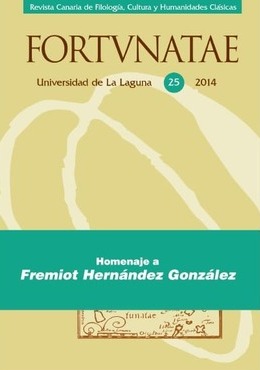Análisis de las relaciones de coherencia en un texto de Cicerón
Resumen
En el presente trabajo se ofrece una visión general de los problemas y métodos de un tipo de investigación que pretende dar cuenta de la coherencia de un texto a través del análisis de las relaciones que contraen las unidades mínimas de discurso que se aíslen. Se toma para ello, como marco de referencia, la Discourse Structure Theory. A continuación, se lleva a cabo un análisis de un fragmento del De amicitia de Cicerón con vistas a detallar su entramado de relaciones de coherencia.
Citas
ASHER, Nicholas & Alex LASCARIDES (1998): «Bridging», Journal of Semantics 15: 83-113.
ASHER, Nicholas & Alex LASCARIDES (2003): Logics of Conversation, Cambridge University Press, Cambridge.
BAIN, Alexander (2005 [1877]): English Composition and Rhetoric. A Manual, Elibron Classics.
CORBLIN, Francis (1995): Les forms de reprise dans le discours. Anaphores et chaînes de reférénce, Rennes, Presses Universitaires de Rennes.
DEL TOMA, Eugenio (1999): Saber comer para vivir más, Madrid, Alianza.
GEERAERTS, Dirk & Hubert CUYCKENS (eds.) (2007): The Oxford Handbook of Cognitive Linguistics, Oxford University Press, Oxford.
GRIMES, Joseph E. (1975): The Thread of Discourse, Mouton Publishers, Berlín, Nueva York, Amsterdam.
HALLIDAY, M. A. K., & Ruqaiya HASAN (1976): Cohesion in English, Longman, Londres.
HALLIDAY, M. A. K. & M. I. M. MATTHIESSEN (2013): Halliday’s Introduction to Functional Grammar, 4ª ed., Routledge, Londres y Nueva York.
HOBBS, Jerry R. (1990): Literature and Cognition, CSLI, Stanford.
HUME, David (1952): An Enquiry Concerning Human Understanding, edited by SELBY-BIGGE, en Great Books of the Western World, vol. 35, Encyclopaedia Britannica, Chicago.
JURAFSKY, Daniel &James H. MARTIN(2003): Speech and Language Processing: An Introduction to Natural Language Processing, Computational Linguistics, and Speech Recognition, Prentice-Hall, Upper Saddle River, N.J.
KEHLER, Andrew (2002): Coherence, Reference, and the Theory of Grammar, CSLI Publications, Stanford.
KROON, Caroline (1995): Discourse Particles in Latin. A Study of nam, enim, autem, vero and at, J.C. Gieben, Amsterdam.
LONGACRE, Robert E. (1996): The Grammar of Discourse, 2ª ed., Plenum, Nueva York.
LONGACRE, Robert E. & Shin Ja J. HWANG (2012): Holistic Discourse Analysis, 2ª ed., SIL International, Dallas, TX.
MANN, William C. & Sandra THOMPSON (eds.) (1992): Discourse Description: Diverse Linguistic Analyses of a Fund-raising Text, John Benjamins Publishing, Amsterdam.
MANN, William C., Christian M. I. M. MATTHIESSEN & Sandra THOMPSON (1992): «Rhetorical StructureTheory and Text Analysis», enMANN,W.C. et al. (eds.), Discourse Description: Diverse Linguistic Analyses of a Fund-raising Text, John Benjamins Publishing, Amsterdam, pp. 39-78.
MARTIN, J. R. (1992): English Text. System and Structure, John Benjamins, Philadelphia/Amsterdam.
SANDERS, Ted (1997): «Semantic and Pragmatic Sources of Coherence: On the Categorization of Coherence Relations in Context», Discourse Processes 24: 119-148.
SANDERS, Ted & Wilpert SPOOREN (2007): «Discourse and Text Structure», en GEERAERTS, Dirk & Hubert CUYCKENS (eds.): The Oxford Handbook of Cognitive Linguistics, Oxford, pp. 916-941.
SIMENON, Georges (1950): L’amie de Madame Maigret, Presses de La Cité.
SMITH, Carlota S. (2003): Modes of Discourse. The Local Structure of Texts, CUP, Cambridge.
WOLF, Florian & Edward GIBSON (2006): Coherence in Natural Language. Data Structures and Applications, The MIT Press, Cambridge, Mass.
M. TVLLI CICERONIS De Re Pvblica, De Legibvs, Cato Maior de Senectvte, Laelivs de Amicitia, J. G. F. POWELL, OCT (2006).
Los autores conservan los derechos de autor y garantizan a la revista el derecho de ser la primera publicación del trabajo al igual que licenciarlo bajo una Creative Commons Attribution License que permite a otros compartir el trabajo con un reconocimiento de la autoría del trabajo y la publicación inicial en esta revista.
Los autores pueden establecer por separado acuerdos adicionales para la distribución no exclusiva de la versión de la obra publicada en la revista (por ejemplo, situarlo en un repositorio institucional o publicarlo en un libro), con un reconocimiento de su publicación inicial en esta revista.





